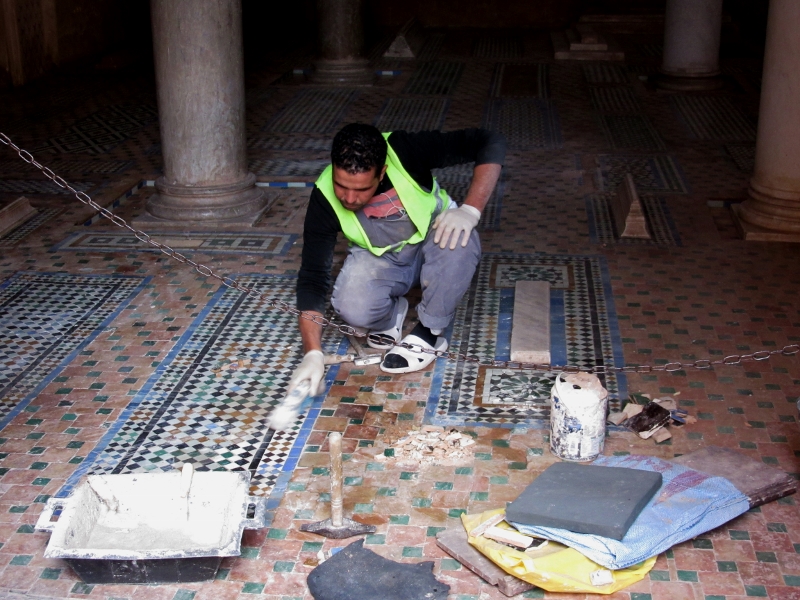


The Man Who Knew Too Much, Hitchcock’s 1956 thriller, with Doris Day and Jimmy Stewart opens in Marrakesh. Ten years later, in 1966, Our Man in Marrakesh aka Bang! Bang! You’re Dead! with Tony Randall and Senta Berger, is part comedy and complete guide to what’s worth seeing in the city.
Even the Absolutely Fab pair spent an episode there. Spielberg filmed Raiders of the Lost Ark in the city in 1981; Scorsese followed in 1988 with The Last Temptation of Christ, and Stone topped it in 2004 with Alexander.
Walking through the narrow, windy streets of the Medina, I half-expected to see someone running from someone else. Car chases would be mad. Motorbike chases a possibility. But the old reliable on-foot dodge-em would be perfect. It’s hard to get a sense of cityscape. But I’d imagine that viewed from above, it would be a different story entirely.
The Saadian Tombs date back to the sixteenth century but lay hidden for years and years and years until 1917 when they were rediscovered during an aerial survey of the city by the French. Located in the Kasbah, next to the mosque, a pathway was built to access them and the grounds reclaimed. Architecturally, they are a fine example of mosaic work and inlay.


It’s thought that they were sealed back at the turn of the eighteenth century when Moulay Ismail was in power. Having destroyed the Badai Palace next door, word has it that superstition intervened and rather than destroying the tombs and risking the wrath of those who had gone before him, Ismail just sealed it all up leaving just one entrance, a well hidden one, open from the Kasbah Mosque.
For two hundred years or so, the dead rested in peace, undisturbed by clicking cameras or littering tourists. Today, it’s a sight to be seen if you’re in Marrakesh – and, in fact, it was the only one we visited on purpose. [I have a thing for cemeteries.]


Sixty-six tombs are housed in the two main mausoleums with another 100 or so graves in the gardens, including, interestingly, a few Jewish ones. The dead are mostly princes or members of the various royal households, their elevated status probably reflected in the brilliance of the mosaic and the intricate carvings of excerpts from the Qu’ran. It’s quite something really. And while you might be shoulder to shoulder with someone as you try to get a peek inside, it still manages to retain that sense of quiet, that air of solemnity.
It’s an ongoing restoration, a painstakingly slow one, a lot of which is done by hand. Just last month I saw something similar going on with tombs in Hyderabad – hand chisels and hand work. And even watching that process is fascinating, in and of itself. It made me wish that I had paid more attention to pronunciation in French class – I might have been able to ask some questions. [Are mosaic artists good at doing jigsaws?]


The walls outside, the shared walls with whatever is next door, are a maze of pigeon nests. It’s hard to know whether they are old bullet holes or mortar holes or whether, as in Malta, they were made with pigeons in mind. I’d be interested to hear if anyone knows more? But perhaps as much as anything else, I was impressed by the tri-lingual write-up in the square outside, written in the first person, as if the square was talking about itself and the sights around it. A new one for me and one that I’d like to see catch on.
